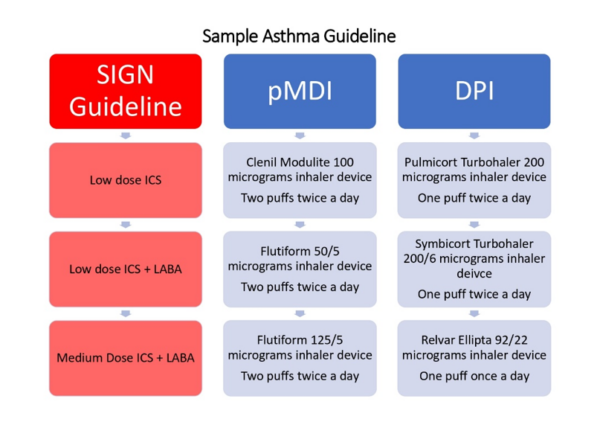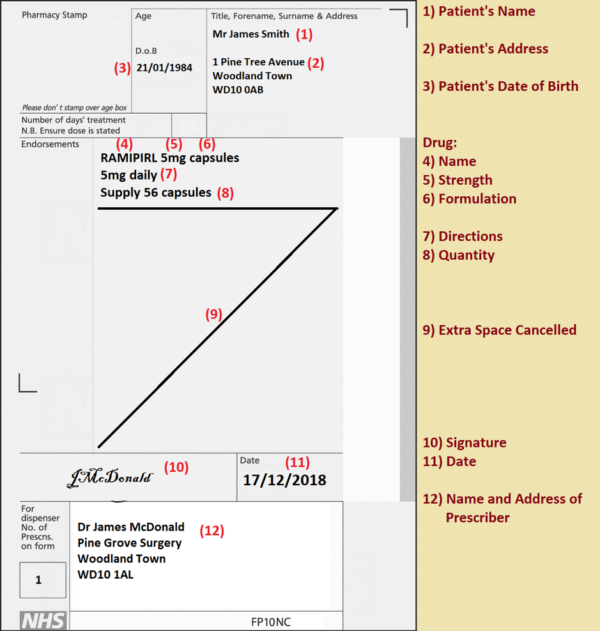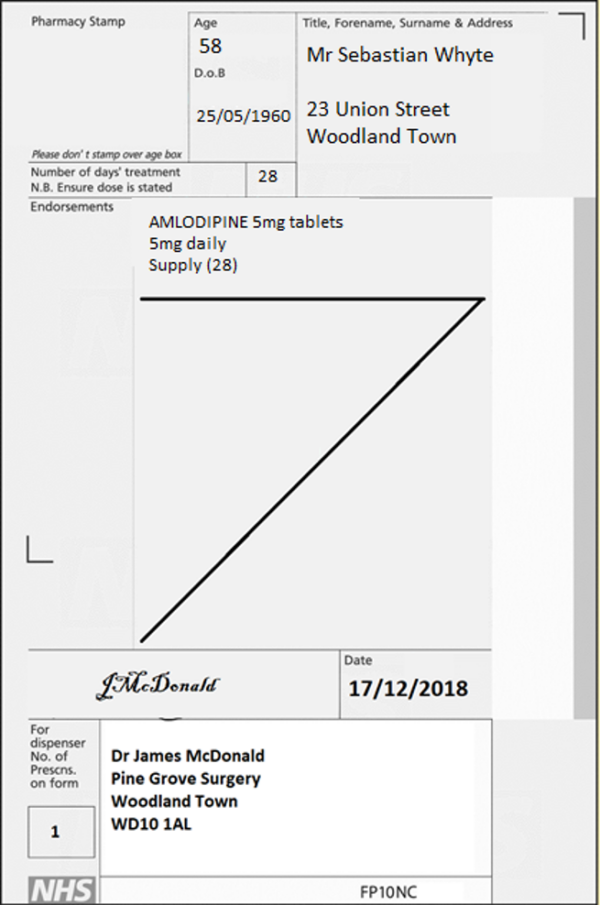- 📖 Geeky Medics OSCE Book
- ⚡ Geeky Medics Bundles
- ✨ 1300+ OSCE Stations
- ✅ OSCE Checklist PDF Booklet
- 🧠 UKMLA AKT Question Bank
- 💊 PSA Question Bank
- 💉 Clinical Skills App
- 🗂️ Flashcard Collections | OSCE, Medicine, Surgery, Anatomy
- 💬 SCA Cases for MRCGP
To be the first to know about our latest videos subscribe to our YouTube channel 🙌
Background
All UK doctors begin work in a hospital environment and become familiar with writing prescriptions on an inpatient prescription and administration record or “Kardex”. However, most prescriptions are issued to patients in a primary care setting and there are some important differences to consider.
Prescription forms
Prescriptions written for NHS patients in primary care are done so on set prescription forms – either as part of a handwritten prescription pad or prescription forms which can be printed on using GP practice computer software. The legal prescription requirements are the same across these forms, but it is important to understand the differences so the correct one is used. The below tables provide an overview of key form colours in each major UK region.
England
Table 1. Prescribing forms in England
All prescription forms originating in England begin with the code FP10.
| Code | Form colour | Issued by | Notes |
|
FP10 FP10NC FP10SS FP10HNC |
GREEN |
GPs Nurse prescribers AHP prescribers Pharmacist prescribers Hospital doctors (outpatient) |
The suffix of the code gives an indication as to the prescriber (e.g. HNC for hospital) |
| FP10MDA | BLUE | Prescribers managing substance misuse patients | Instalment dispensing prescriptions for the purpose of treating addiction. |
|
FP10SP FP10PN |
LILAC | Community/independent nurse prescribers and AHP prescribers | |
| FP10D | YELLOW | Dentists |
Wales
Table 2. Prescribing forms in Wales
| Code | Form colour | Issued by | Notes |
|
WP10 WP10SS WP10SP WP10HP WP10HSP |
GREEN | GPs, hospitals and supplementary prescribers | The suffix of the code gives an indication as to the prescriber (e.g. HP for hospital) |
|
WP10MDA WP10HP(AD) |
GREEN | Prescribers managing substance misuse patients | Instalment dispensing prescriptions for the purpose of treating addiction. |
|
WP10CN WP10PN |
GREEN | Community/independent nurse prescribers | |
| WP10D | GREEN | Dentists |
Scotland
Table 3. Prescribing forms in Scotland
| Code | Form colour | Issued by | Notes |
|
GP10 GP10(SS) |
PEACH | GPs | |
| HBP(A) | PINK | Prescribers managing substance misuse patients | Instalment dispensing prescriptions for the purpose of treating addiction. |
| GP10(N) | LILAC | Nurse prescribers | |
| HBP | BLUE | Hospital-based prescribers | |
| GP14 | YELLOW | Dentists |
Northern Ireland
Table 4. Prescribing forms in Northern Ireland
| Code | Form colour | Issued by | Notes |
|
HS21 HS21CS |
SHADED GREEN AND PINK |
GPs | |
|
HS21X HS21XCS |
SHADED GREEN AND PINK |
Non-medical prescribers | |
|
HS21N HS21NCS |
SHADED GREEN AND PINK |
Community nurses | |
| HS21D | YELLOW | Dentists |
Sources of information
Before you put pen to one of these forms it is important you have all the right information to hand so that your prescription is safe and correct.
Local formulary
A good place to start is the local formulary for your NHS Board/Trust. These give information on which drugs to prescribe per class/indication, usually based on clinical guidelines (such as NICE/SIGN) and cost. For example, if you have an adult patient with asthma and wish to prescribe an inhaled corticosteroid, your local formulary will indicate which to consider the first line. In this fictional example, this would be Clenil Modulite 100 micrograms inhaler as this is the most cost-effective option.

British National Formulary (BNF)
The BNF is the go-to resource for drugs information in the UK. It is available as a printed book, mobile app or website. The BNF is organised into 16 main chapters which are subdivided by condition, the drugs are then organised under the conditions by class. Be sure to check both the condition summary, class monograph and drugs monograph as important information for your drug may be included in the class monograph and not repeated for each individual drug.

Summary of product characteristics
Each licensed medicine in the UK has a “Summary of Product Characteristics” available on medicines.org.uk. These contain more detailed information beyond what is contained in the BNF and are a useful source of further information if your query is not answered by the BNF.
Pharmacists and medicines information services
Pharmacists are experts in the use of medicines and are an excellent source of advice if you are not sure about something. Many GP practices employ pharmacists in house, otherwise, those working in community pharmacy may also be able to help you. For more specialist advice there are Medicines Information Services around the UK whose contact details are located within the BNF.
Patient-specific factors
Before you go ahead and prescribe your drug of choice, it is important to consider the specific patient in front of you. The headlines below can be used as a checklist when prescribing to make sure you have considered them when deciding if your prescription is appropriate.
Table 5. Prescribing in specific patient groups
| Age | Children and elderly patients are at higher risk of prescribing complications, so take special care. |
| Weight | Do you have the patient’s current weight for dose calculation? |
| Renal impairment |
Will the excretion of this drug be affected? Can this drug worsen renal impairment? |
| Hepatic impairment | Will the metabolism of this drug be affected? |
| Pregnancy and breastfeeding |
Is this drug known to be safe? What are the benefits vs risks? |
| Other drugs/conditions |
Are there interactions? Will this drug worsen another condition (check contraindications and cautions in BNF)? |
Prescription requirements
All prescriptions, regardless of if they are written on a hospital chart, primary care prescription form or as a private prescription have the same basic requirements.
All prescriptions must:
- State the name and address of the patient
- Be written or printed legibly in ink
- Be signed in indelible ink
- Have an appropriate date (usually the date of signing)
- State the address of the prescriber
- State the age of a child under 12
It is good practice to:
- Include the age and date of birth of the patient
- State the weight of the patient where it has been used for a dose calculation
Details of the medicine to include:
- Name of medicine (generic name unless a specific brand must be given)
- Form (e.g. tablets, oral suspension)
- Strength (e.g. 5mg for tablets or 125mg/5ml for an oral suspension): units and acceptable abbreviations are shown in Table 6.
- Directions: should include quantity and frequency and for liquid preparations, it is best practice to write directions using the mass of active ingredient rather than volume so the pharmacist is clear on the dosage (especially for oral suspensions i.e. 125mg rather than 5ml).
- Quantity to be supplied (e.g. 56 tablets)
Table 6. Common drug units and associated abbreviations
| Unit | Abbreviation |
| Grams | g |
| Milligrams | mg |
| Micrograms | Must be written in full (micrograms) |
| Nanograms | Must be written in full (nanograms) |
| Litres | L |
| Millilitres | mL |
| International units | Units (not iu or u) |

Legal classifications and controlled drugs
Medicines licensed for use in the UK can be broken down into four basic categories.
General sales list (GSL)
Those medicines which can be purchased from any shop, for example, a petrol station, such as paracetamol.
Pharmacy only (P)
Medicines which may only be sold in a pharmacy by a pharmacist or their supervised staff.
Prescription only medicines (POM)
Medicines which are only available with a valid prescription.
Controlled drug
Prescription-only medicines which are subject to extra prescription requirements.
Prescribing restrictions
Most drugs that are GSL, P or POM may be prescribed as described above (however some health boards/trusts are restricting prescribing of GSL and P medicines to encourage patients to buy these themselves). Controlled drugs are subject to extra prescription requirements which are covered in the controlled drug prescribing article. You can find out which category a drug falls into in the BNF.
Sample problems
For all of the sample problems below, assume today’s date is 17/12/2018.
Case 1
Mr Sebastian Whyte 25/05/1960 of 23 Union Street, Woodland Town is a 58-year-old male who has been recently diagnosed with essential hypertension and has no past medical history. You decide to prescribe an antihypertensive and the first-line drug in your area is amlodipine. Please write a prescription using a blank FP10 prescription form and then compare against the example below.
This question requires you to check the starting dose in the BNF and write a legally valid prescription (N.B. age and duration of treatment are not legally required).
Case 2
Miss Laura Brown 04/06/1995 of Flat D 22 University Road, Woodland Town WD12 1MN presents with an itchy left eye with yellow discharge that stuck her eye closed this morning. She denies pain and does not use contact lenses.
Bacterial conjunctivitis
Please write a prescription for an appropriate eye drop to treat this problem using a blank FP10 prescription form and then compare against the example below.
This question requires you to check the recommended treatment for bacterial conjunctivitis in the BNF and write a legally valid prescription. It is helpful to look at the available pack sizes in the BNF to choose an appropriate quantity to prescribe. If you do not specify a quantity the pharmacist will issue the smallest pack available.
Other acceptable directions include:
- Apply ONE drop to the LEFT eye at least every TWO hours then reduce the frequency as an infection is controlled and continue for 48 hours after healing.
- Apply ONE drop to the LEFT eye every TWO hours for the first two days and then four hourly for three days.
Case 3
Master Alex Johnson 12/09/2011 of Home Farm, Woodland Town WD10 1FA has been seen by the Child and Adolescent Psychiatry Team who have diagnosed him with ADHD. You are to issue a prescription for his Concerta XL under shared care arrangements. He is currently taking 18mg in the morning. Please write a prescription using a blank FP10 prescription form and then compare against the example below.
This question is a test of controlled drug prescribing – have a look at the controlled drug prescribing guide for more information. It is best practice to issue a maximum of thirty days supply at a time for CD medicines. As this is a prescription for a child under 12, the age should be entered in the age box.
References
- Datapharm Communications Ltd. About the eMC. Published in 2019. Available at: [LINK]
- Joint Formulary Committee. British National Formulary. Published in 2020. Available at: [LINK]
- Pharmaceutical Services Negotiating Committee Is this prescription form valid? Published in 2018. Available at: [LINK]
- Royal Pharmaceutical Society of Great Britain. Medicines, Ethics and Practice: The professional guide for pharmacists. Published in 2014. Available at: [LINK]
Reviewer
Dr Lyndsey McConnell
Consultant General Practitioner







